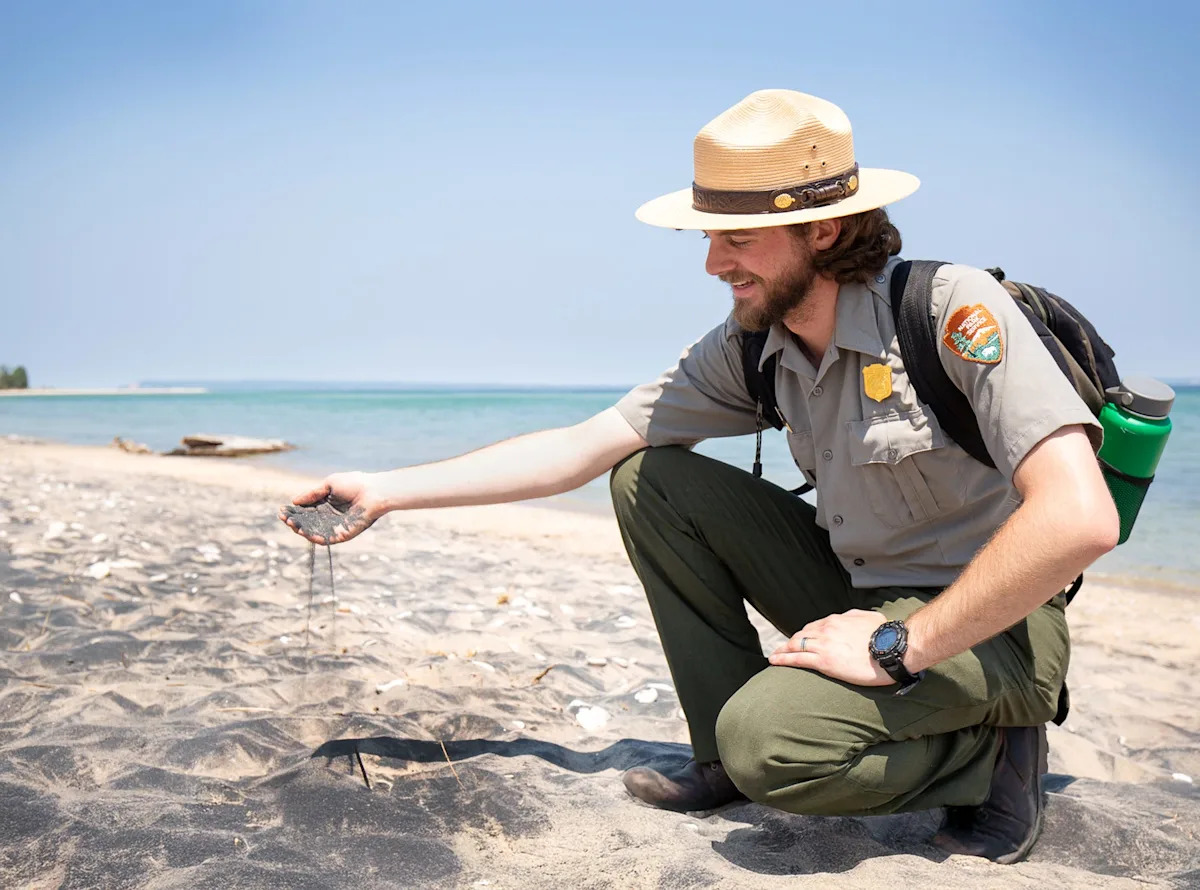
Finding black streaks or splotches in the sand while walking along a Michigan beach may have you wondering if you’ve stumbled across some sort of pollution, but it’s actually a completely natural phenomenon in most cases.
Michigan beaches often are streaked with an iron-based mineral called magnetite, the National Park Service pointed out this week in a Facebook post.
“Have you ever been walking the beaches at Sleeping Bear Dunes National Lakeshore and noticed patches of dark sand? Congratulations! You have stumbled upon some magnetite,” the park service said in the post. “Sand here of course contains magnetite, usually accompanied by hematite — a mineral that gives it its signature color, but (the sand is) primarily made of quartz! Of quartz it is.”
The dark-colored magnetite can be separated from the quartz with a hand magnet.
Here’s what to know about magnetite and black sand in Michigan.
A National Park Service ranger at Sleeping Bear Dunes National Lakeshore shows magnetite-laden sand at the park’s beach.
What is magnetite?
Magnetite is a mineral whose primary component is an iron oxide that contains iron, the American Chemical Society.
“Magnetite’s greatest use is as an important iron ore for steel manufacture,” the society said.
The University of Wisconsin’s Virtual Museum of Minerals and Molecules says magnetite is one of the most ubiquitous of all minerals, occurring in a wide variety of igneous, metamorphic, and sedimentary rocks.
What is hematite?
Hematite is an iron oxide, which means it’s made of rust, the International Gemological Institute said.
Hematite is the product of many iron-bearing minerals, especially, magnetite, siderite, and pyrite, the University of Wisconsin’s Virtual Museum of Minerals and Molecules says.
What is quartz?
Quartz is one of the most common minerals in the Earth’s crust, according to the Minerals Education Coalition. Quartz is physically and chemically resistant to weathering. When quartz-bearing rocks become weathered and eroded, the grains of resistant quartz are concentrated in the soil, in rivers, and on beaches. The white sands typically found in river beds and on beaches are usually composed mainly of quartz.
Does Michigan have any other ‘black sand’ beaches?
The shoreline along the eastern Keweenaw Peninsula near Gay is covered in black sand, although it was created differently.
The black sands near Gay are the remnants of copper mining operations a century ago and are known as “stamp sands.”
The material in Lake Superior is the result of a stamp mill crushing copper-containing rock to separate the pure copper and then dumping the remnants into the lake.
Where is Sleeping Bear Dunes National Lakeshore?
Sleeping Bear Dunes National Lakeshore lies along 35 miles of Lake Michigan’s eastern shoreline in northwest Michigan, west of Traverse City. Nearby are the villages of Glen Arbor and Empire. The lakeshore is about 39 miles from Traverse City. M-22 runs north and south along the lakeshore.
This article originally appeared on Lansing State Journal: Magnetite can give beach sand a dark color. What to know about the mineral in Michigan
Disclaimer: This news has been automatically collected from the source link above. Our website does not create, edit, or publish the content. All information, statements, and opinions expressed belong solely to the original publisher. We are not responsible or liable for the accuracy, reliability, or completeness of any news, nor for any statements, views, or claims made in the content. All rights remain with the respective source.
